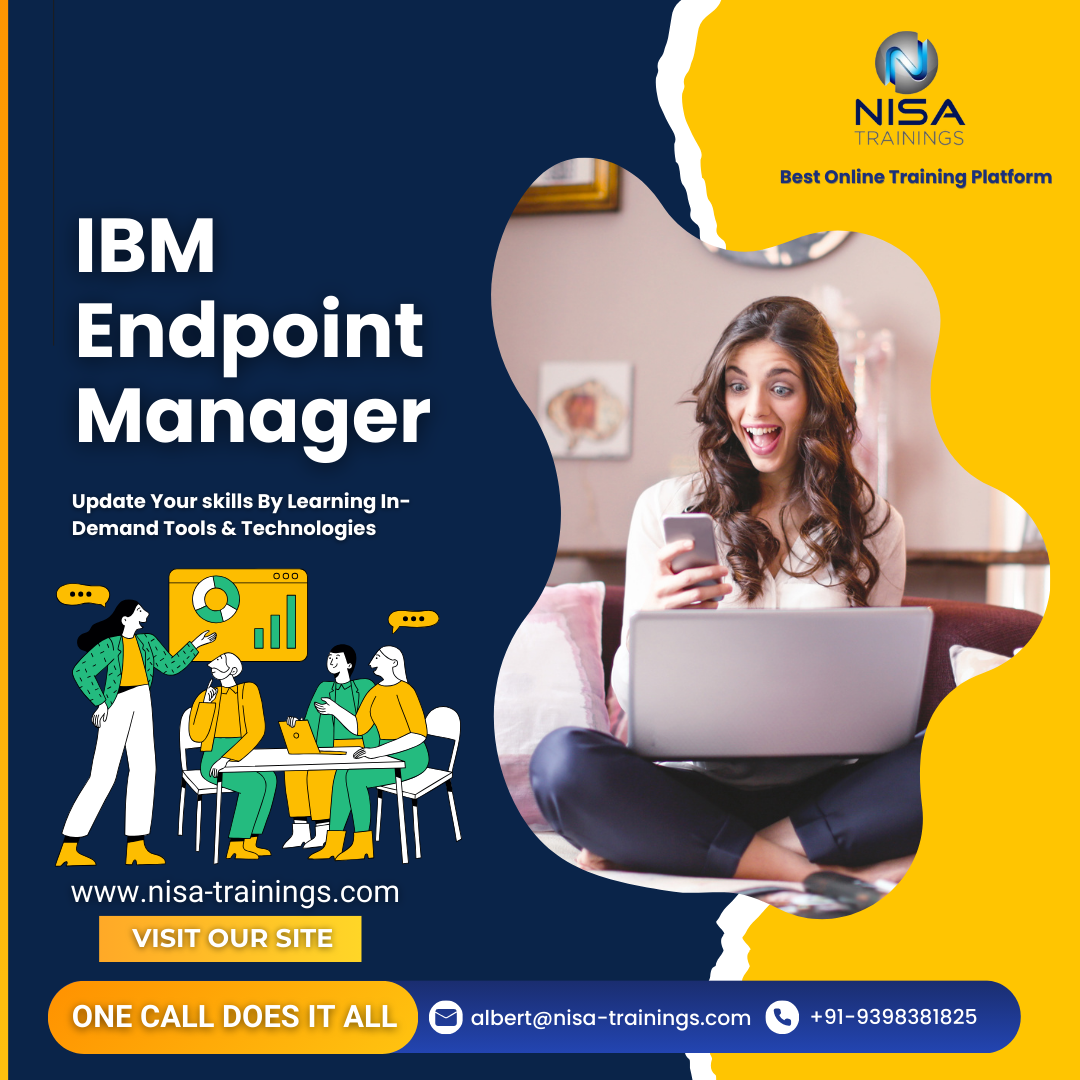IBM Endpoint Manager Training
IBM Endpoint Manager (IEM) is a comprehensive endpoint management solution designed to help organizations manage and secure their devices, applications, and data across various platforms. IEM was previously an IBM product that allowed organizations to efficiently monitor, manage, and secure their IT infrastructure by automating processes related to endpoint configuration, software deployment, patch management, and security.

Why should you choose Nisa For IBM Endpoint Manager Training?
Nisa Trainings is the best online training platform for conducting one-on-one interactive live sessions with a 1:1 student-teacher ratio. You can gain hands-on experience by working on near-real-time projects under the guidance of our experienced faculty. We support you even after the completion of the course and happy to clarify your doubts anytime. Our teaching style at Nisa Trainings is entirely hands-on. You’ll have access to our desktop screen and will be actively conducting hands-on labs on your desktop.
Job Assistance
If you face any problem while working on IBM Endpoint Manager Course, then Nisa Trainings is simply a Call/Text/Email away to assist you. We offer Online Job Support for professionals to assist them and to solve their problems in real-time.
The Process we follow for our Online Job Support Service:
- We receive your inquiry for Online Job
- We will arrange a telephone call with our consultant to grasp your complete requirement and the tools you’re
- If our consultant is 100% confident in taking up your requirement and when you are also comfortable with our consultant, we will only agree to provide service. And then you have to make the payment to get the service from
- We will fix the timing for Online Job Support as mutually agreed by you and our consultant.
Course Information
IBM Endpoint Manager Training
Duration: 25 Hours
Timings: Weekdays (1-2 Hours per day) [OR] Weekends (2-3 Hours per day)
Training Method: Instructor Led Online One-on-One Live Interactive
Sessions.
COURSE CONTENT :
1. Introduction to IBM Endpoint Manager
- Overview of Endpoint Management: Understanding the need for endpoint management in modern IT environments.
- IBM Endpoint Manager Architecture: Basic components, such as the server, agents, consoles, and databases.
- Deployment Scenarios: How to deploy IBM Endpoint Manager in an organization’s infrastructure.
2. IBM Endpoint Manager Installation and Setup
- System Requirements: Hardware and software requirements for installing IBM Endpoint Manager.
- Installation Process: Step-by-step instructions for installing the Endpoint Manager server, console, and clients.
- Basic Configuration: Initial configuration, including setting up the server, agent deployment, and the web console.
3. Endpoint Management and Configuration
- Creating and Managing Endpoint Groups: Categorizing endpoints by operating systems, location, or user groups.
- Policy and Profile Management: Configuring and enforcing policies (security, software, compliance).
- Managing Endpoint Inventory: Tracking hardware, software, and asset information.
4. Software Distribution and Management
- Software Deployment: Creating, testing, and deploying software packages to endpoints.
- Application Management: Managing software updates, upgrades, and installations remotely.
- Patch Management: Setting up automated patch distribution and managing software updates for both operating systems and third-party applications.
5. Security Management
- Security Patches and Vulnerability Management: Ensuring that endpoints are updated with the latest patches to minimize security risks.
- Endpoint Hardening and Configuration Management: Configuring firewalls, antivirus settings, and other security features.
- Compliance and Auditing: Enforcing security policies to maintain compliance with regulatory standards (e.g., HIPAA, PCI-DSS).
6. Remote Control and Troubleshooting
- Remote Desktop Control: Using IBM Endpoint Manager for remote control and troubleshooting of endpoints.
- Diagnostics and Monitoring: Analyzing endpoint performance and resolving issues using real-time monitoring tools.
- Automated Scripts: Using scripts for automated troubleshooting and endpoint maintenance.
7. Managing Endpoints on Different Platforms
- Windows Endpoint Management: Managing Windows PCs and servers.
- macOS and Linux Management: Configuring and managing Apple macOS and Linux systems.
- Mobile Device Management (MDM): Managing mobile devices (iOS, Android) using IBM Endpoint Manager (IBM MaaS360 if focusing on mobile).
- Cross-platform Configuration and Management: Techniques for managing heterogeneous environments.
8. Patch Management and Vulnerability Remediation
- Automating Patch Deployment: Scheduling and automating patch cycles for operating systems and third-party applications.
- Patch Evaluation and Testing: Testing patches before deployment to ensure no negative impact on systems.
- Patch Compliance Reporting: Analyzing and reporting on patch deployment status and compliance.
9. Reporting and Analytics
- Reporting Features: Generating reports for software deployments, patch status, endpoint compliance, and inventory management.
- Custom Reports: Creating customized reports for specific organizational needs.
- Monitoring and Alerts: Setting up alerts to notify administrators of endpoint issues, vulnerabilities, or non-compliance.
10. Automation and Scripting
- Creating Custom Automation: Using IBM Endpoint Manager’s built-in automation tools and scripts for tasks such as software deployment and system configuration.
- Action Scripts: Writing and deploying action scripts to automate regular maintenance tasks.
11. Troubleshooting and Support
- Common Issues: Identifying and troubleshooting common issues during deployment and management.
- Logs and Diagnostics: Analyzing log files to troubleshoot and resolve issues with endpoints or the Endpoint Manager system.
- Best Practices for Troubleshooting: Step-by-step techniques for diagnosing issues and resolving them efficiently.
